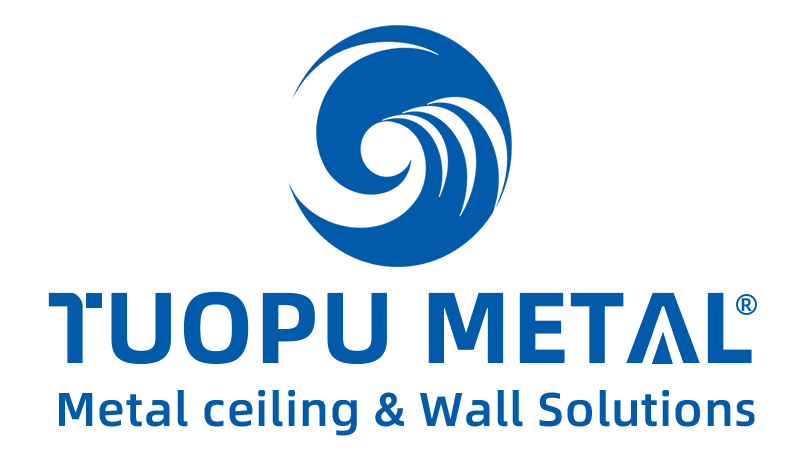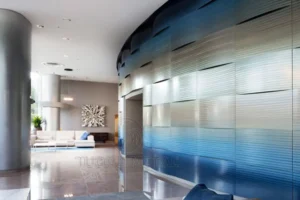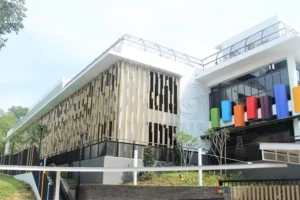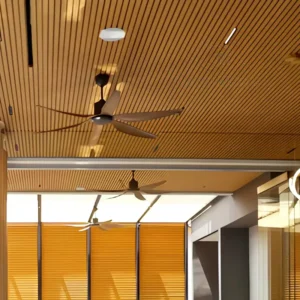1. Introduction: The Role of Aluminum Cladding in Modern Architectures
Aluminum cladding has recently gained popularity alongside other cladding materials such as plastics, composite materials, and glass. The stiff, modern look aluminum gives eye-catching beauty to buildings, and at the same time protects it from harsh weather conditions. For architects and constructors, without a doubt, waterproofing is fundamental, as it poses an additional precautionary measure against damage caused by weather, thus why aluminum cladding makes its perfect for modern, effortless and efficient facades.

2. What Does Waterproofing Mean for Building Materials?
2.1 Definition of Waterproofing
Waterproofing refers to the ability of building materials to resist water penetration. Making it so forms an integral part of preserving buildings from any damage, as it can greatly affect the life and strength of the structure. For example, waterproofing on building facades works to retain the exterior cladding, keeping the building functional and splendid in appearance for decades.
2.2 Consequences of Poor Waterproofing in Building Facades
The consequences of inadequate waterproofing can be dire. Water intrusion may lead to damp stains, long term corrosion, and even destruction of the central supportive framework of the building. Bluntly speaking, existence of mold or mildew is a health peril especially for the residents of the affected buildings. Poor waterproofing always escalates maintenance expenditure due to the need for constant repairs to the moisture damage. It is always a matter of fact that expense control as well as the expected durability mandate the selection of waterproof building products, such as aluminum cladding, by the architects and builders.
3. Is Aluminum Cladding Naturally Waterproof?
3.1 Characteristics of Aluminum and Performance of Water Refusal
Aluminum covers are popular in contemporary building facades as they are resistant to water by default. This is largely attributed to the protective oxide layer that aluminum possesses. When aluminum is put in air, it develops a thin, but relatively robust aluminum oxide layer which prevents moisture and oxidation. As a result, the material remains aesthetically pleasing and does not corrode or becomes damaged even after enduring extreme weather. Furthermore, since aluminum is not hygroscopic, it is perfect for preventing water retention in building structures.
3.2 Comparing Aluminum Cladding with Other Cladding Materials
When compared to other cladding materials, aluminum stands out for its superior waterproofing properties.
| Material | Waterproof Performance | Potential Issues |
| Aluminum Cladding | Naturally resistant to moisture and corrosion, maintaining durability and requiring minimal maintenance. | – |
| Wood | Prone to water absorption, which can lead to warping, rot, and high maintenance needs. | Warping, rot, and constant maintenance due to water absorption. |
| Vinyl Cladding | Resistant to moisture, but may crack or warp when exposed to temperature fluctuations, potentially allowing water infiltration. | Cracking and warping under temperature changes, which compromises waterproofing. |
| Steel | Strong but susceptible to rust if not properly treated and maintained, which can compromise its waterproof abilities. | Rust formation due to moisture exposure without proper treatment and maintenance. |
Aluminum cladding provides a great solution for architects and builders since it incorporates durability, lower weight, resistance to corrosion, and reduced maintenance requirements. Its natural water resistance, coupled with its aesthetic appeal, makes it easy to see why many architects and builders as designers and builders wish to incorporate style and functionality into their projects prefer it.
In summary, the waterproof features of aluminum cladding serves as a benefit to builders and designers who are looking for long-lasting weather resistant protective structures for their buildings.
4. Factors That Influence the Waterproof Performance of Aluminum Cladding
4.1 Quality of Material and Coating
The waterproofing performance of aluminum cladding is directly related to the quality of the aluminum material used along with the quality of its protective coating. The element’s endurance puts it hand in hand with high-grade anodized aluminum, which defends better against corrosion. PVDF coating, along with other coatings, serve to enhance the component’s surface by enabling better resistance against moisture, UV radiation, and pollutants thereby ensuring the cladding’s depended efficiency over time.
4.2 Installation Techniques
To keep up the waterproofing efficiency of aluminum cladding, proper installation in all facets is important. The use of appropriate sealants, overlaps of the panels, and fastening of the covers ensure no water infiltrates beyond the cladding. An installation contractor will make sure that joints are sealed against water intrusion and that the system is configured to promote drainage without the obstruction of debris.
4.3 Maintenance Practices
Aluminum cladding has waterproofing features, and any ongoing maintenance will aid in preserving those features. Regular inspections are conducted to pinpoint any signs of damage that can impact the cladding’s protective covering. Regular washing helps prevent accumulation of dirt that can interfere with the protective layers of the aluminum cladding, thus allowing it to function efficiently. Proper maintenance of the cladding guarantees that it withstands harmful weather for many years.

5. Additional Aluminum Cladding Waterproofing Options
5.1 Barriers and Waterproof Coatings
Sealants that help seal joints and seams and stop water infiltration include silicone and polyurethane. Even in severe weather, waterproof membranes placed behind aluminum cladding provide an additional layer of defense and improve moisture resistance.
5.2 Systems for Drainage and Flashing
Whereas drainage systems divert moisture from the building, flashing keeps water away from vital places like windows and joints. These remedies combine to keep water from accumulating and preserve the waterproofness of the cladding.
6. Advantages Of Waterproof Aluminum Cladding
6.1 Improved Life Span
Structures are much greater shielded against water destruction, which can cause cracking, peeling, rusting, and corrosion as a result of waterproofing. The aluminum further provides waterproofing. Aluminum does not get ruptured under different environmental activities.
6.2 Decreased Expenses
With the waterproofing solution aluminum cladding specifically designed for water, damages caused by water will diminish. Therefore, aluminum costs for repairs will dramatically decrease, resulting in a decreased cost in the long term. Such cladding will surely provide great benefits for contractors and property owners alike.
6.3 Enhanced Look Of The Building
Such waterproofing makes it possible to preserve the overall looks of the aluminum cladding. The absence of water spots, rust, and other such stains, improves the value and aesthetic quality of the building. It also improves the curb appeal of the building. In particular, commercial buildings will attract more clients, yielding enhanced profit margins.
7. Professional Advice on Selecting the Greatest Waterproof Aluminum Cladding
- Give priority to superior coatings: To avoid corrosion and water damage, look for aluminum cladding with long-lasting, protective coatings.
- Select designs for smart panels: To improve waterproofing, choose overlapping panels or integrated drainage systems.
- Ascertain expert installation: To ensure correct sealing and safe panel placement, collaborate with skilled installers.
- Align appearance and functionality: Choose cladding that satisfies performance and waterproofing requirements while blending in with the architecture of your building.
- Verify the credentials: For extra peace of mind, confirm that the cladding satisfies industry waterproofing standards.
8. Conclusion: How Waterproof Aluminum Cladding Provides Value Over Time
In essence, aluminum cladding thoroughly covers all the bases with respect to waterproofing. Its versatility in applications makes it highly durable, which is an advantageous feature for modern architectural designs. It will retain the aesthetic beauty of the building while expertly preserving it.
If you are planning a new construction project and how to best incorporate aluminum cladding, reach out to the expert team at Top Metal for more information on its amazing benefits.
Call us today to see how your vision for aluminum cladding can be achieved, and make your building projects a success well into the future.








